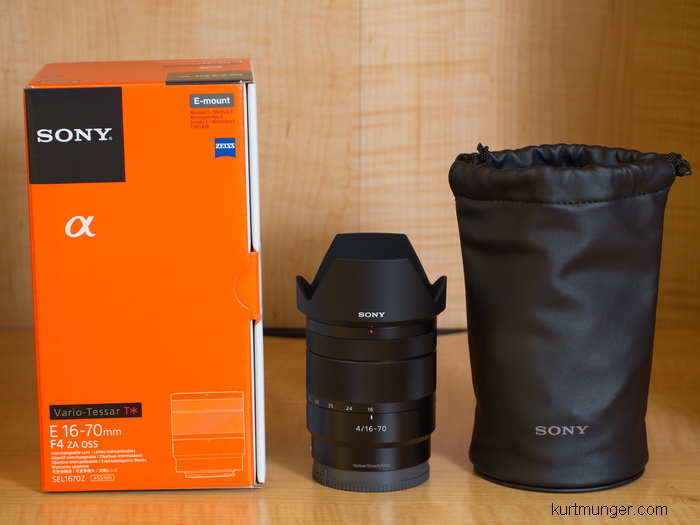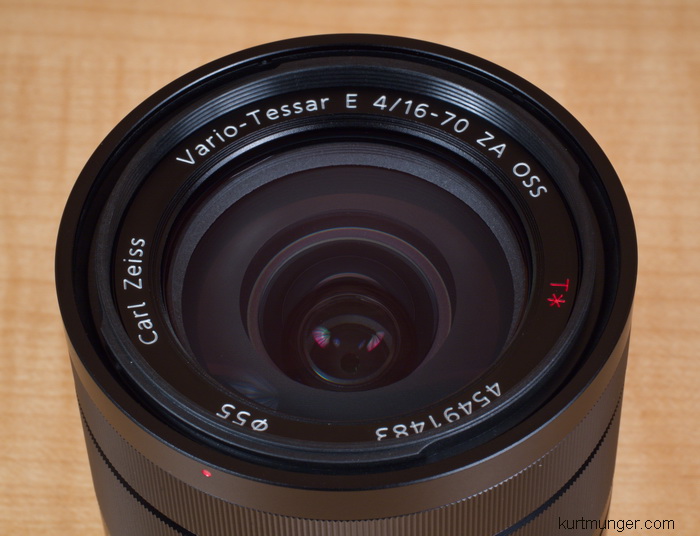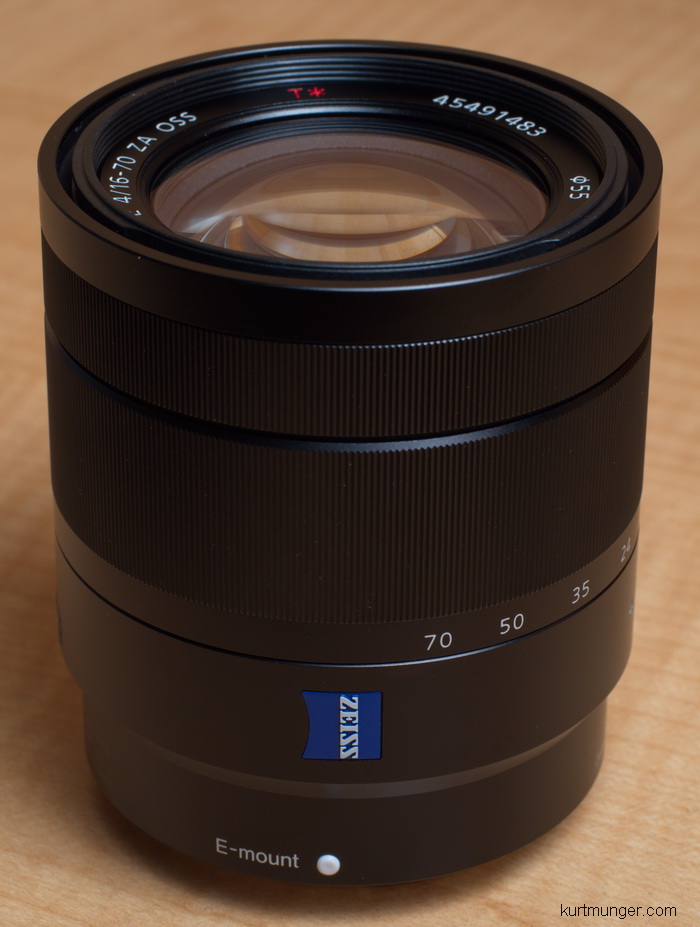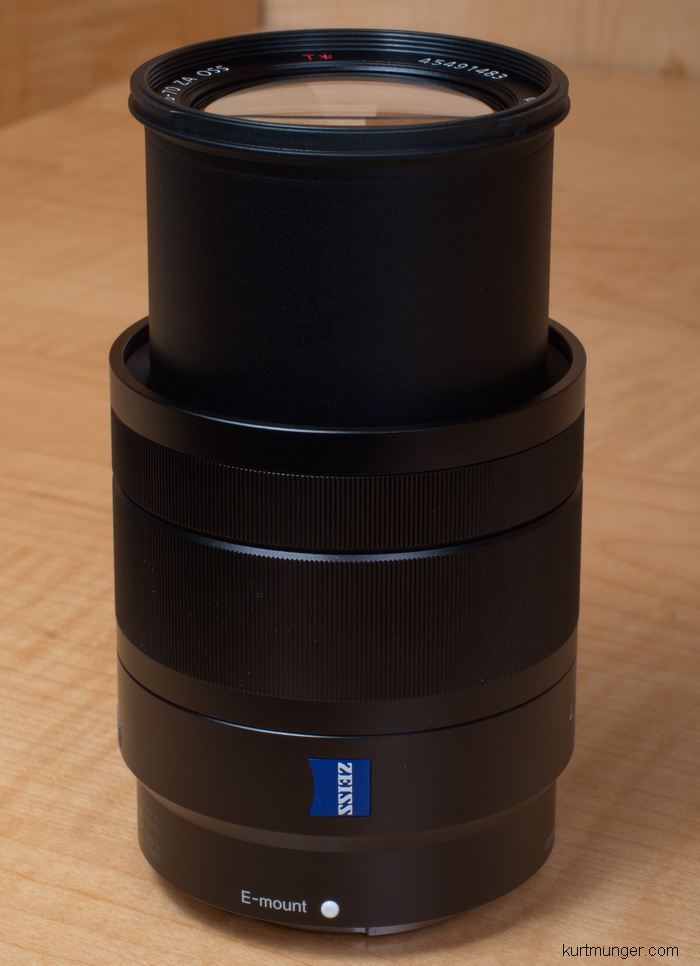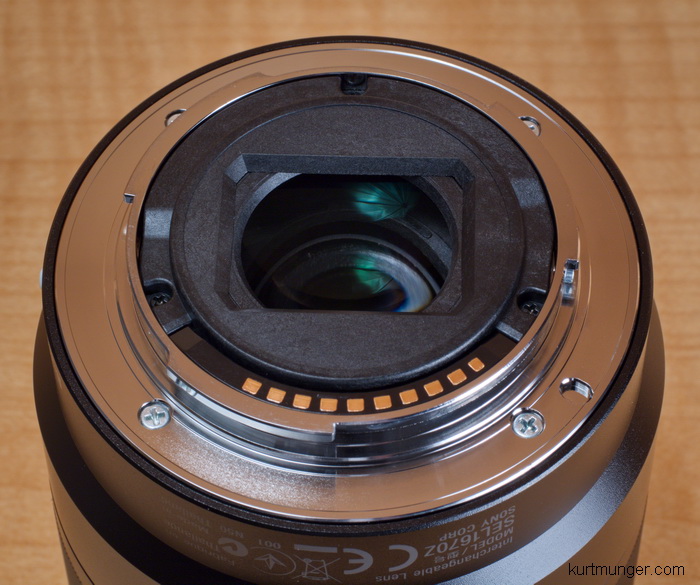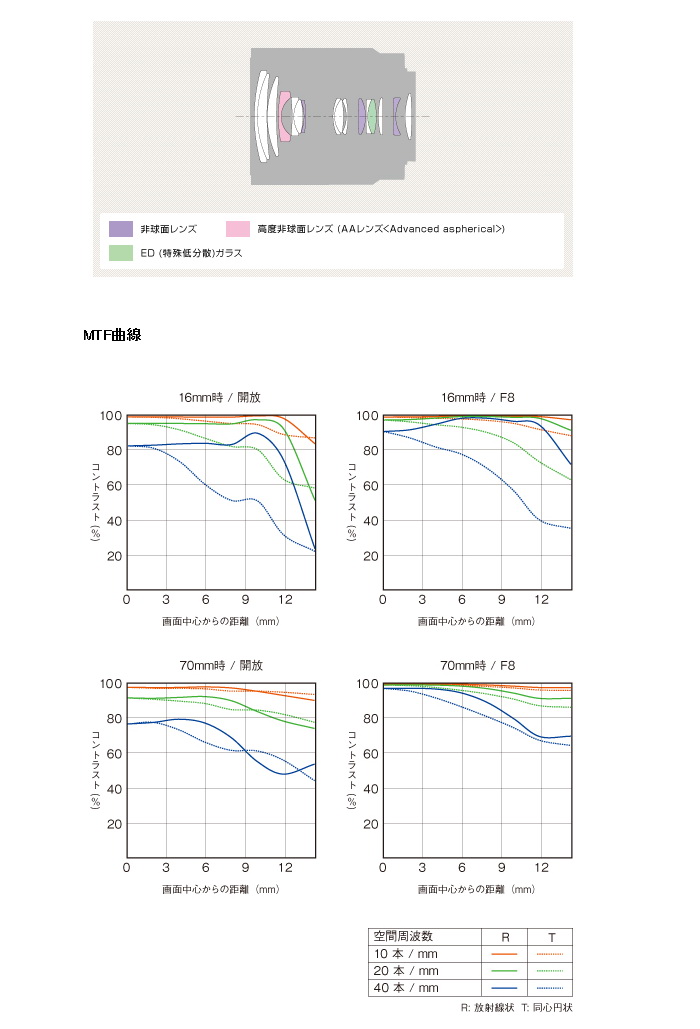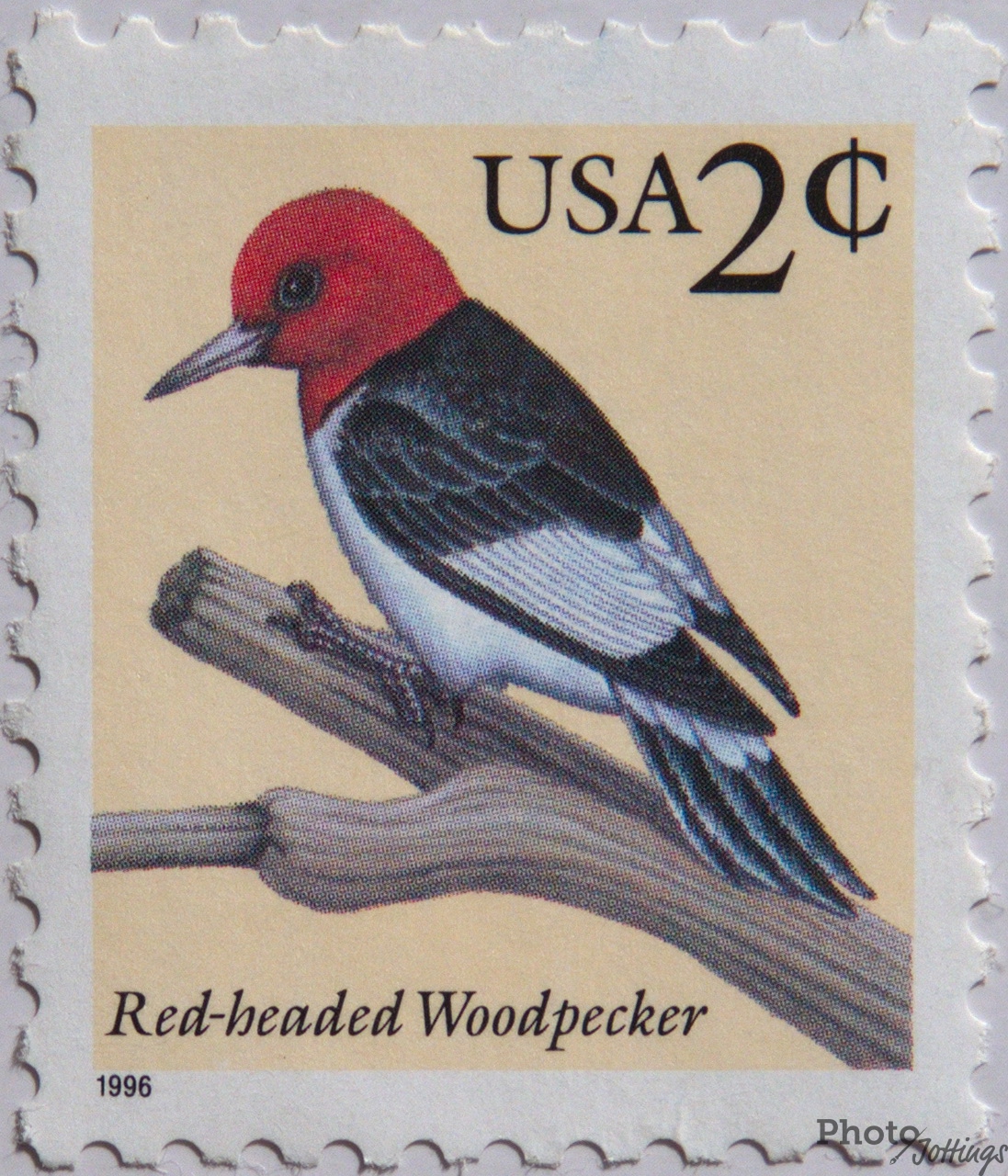|
Full review of the Sony Zeiss E Vario-Tessar T* 16-70mm F/4 ZA OSS
The Sony NEX-C3 was used for this review.
For a better understanding of terms and methods used in this review, go here.
The usual center, mid-section and corner crops are located at the very bottom of the page.
Introduction.
The Sony e mount 16-70mm F/4 (Made in Thailand) is a very compact and light-weight constant aperture wide to medium zoom lens specifically designed for Sony’s APS-C mirrorless camera system. Sony packed this lens with OSS or Optical SteadyShot, 55mm filter threads, a very quiet focusing motor for video nuts, and threw in a petal type hood for good measure. Also included are three aspheric elements, plus one ‘advanced’ aspheric element, and one ‘ED’ element in the design. Fit and finish are quite good. The lens is clad in high quality plastic, including the filter threads, (so be careful), but has a metal mount for added durability. Focus and zoom rings have a very tight ribbed design, and are not rubberized, so they won’t turn chalky over time like the full frame and ‘DT’ lenses. The zoom action is smooth and damped properly in my opinion, (one finger zooming is possible) and holds its position well, so there is no zoom creep during normal use; which is good as there is no zoom lock. There is a single plastic extension barrel that protrudes a maximum of 39mm at the 70mm zoom length, and is fully seated at 16mm. Focal length index marks come at 16mm, 24mm, 35mm, 50mm, and 70mm. The EXIF date mostly matches those lengths, but may be off by a millimeter or two at each setting.
In the box: the lens in bubble wrap, front and rear caps, a petal type plastic hood, carrying case, and owner’s manual.
Focusing. This lens auto-focuses almost silently. Focusing seems quite accurate at all focal lengths, and reasonably quick in good light, however, your mileage may vary depending on camera model.
Requisite product shots.
General information and specifications.
Optical qualities summary.
Lens flare/ghosting. Some small to medium green colored blobs appear when super bright light sources are close to, or inside the frame, samples below.
Color fringing (CA). Very good control at all focal lengths, but a little lateral type is noticeable at the wide end if you look very closely.
Bokeh. Sometimes can be smooth, or a little ‘busy’ at certain focusing distances, apertures and focal lengths.
Color. Neutral.
Close up filter. N/A.
Coma. None.
Regular filters cause no problems with vignetting at any focal length.
Filter size:. 55mm.
Distortion. Low at all focal lengths, but ‘wavy’ and hard to fully correct from 16-18mm. Check out the cropped samples below.
Distortion is a little wavy in uncorrected images like RAW at 16mm, but zooming out slightly corrects much of that. From 24-70mm there is some pincushion, but is mostly correctable with standard distortion sliders. If you shoot jpegs and have a newer Sony cameras, you don’t need to worry about this.
Light fall-off.
Light fall-off is mostly mild at all focal lengths. No problems with standard width filters at F/4. For some reason the 16mm F/5.6 crop on the top right looks darker than the F/4 on the left, but I think it may be an aperture control issue. I didn’t get the crops mixed up as the exif matches the crops. Flare and ghosting.
The Sony e-mount 16-70mm F/4 OSS is not all that great in controlling ghosting. Contrast holds up reasonable well even with the sun blazing in the lens, especially at the wide end. Bokeh samples.
Bokeh looks pretty smooth at the wide end when you focus on something close, and the background is far away. The character of out of focus highlights is fairly smooth at F/4 throughout the zoom length, but starts to show aspheric lines inside the discs at F/5 and smaller.
Let’s check out the close focus capabilities of this lens.
Check out the 100% cropped portion of the full image. The sample shot was taken with the Sony NEX-C3 16mp camera, so don’t compare it to others that were taken with 12 or 24mp cameras. The subject is a standard US stamp, 0.87″x 1.0″ or 22mm x 25mm. Also, note the shot was taken as close to the subject as focusing allowed; in this case a short 8.4″ (213mm), measured from the front of the lens barrel to the subject.
This lens has an average (medium zoom lens) reproduction size of 0.23x, (1:4.3). It produced a sharp close focus shot at F/5.6. As a side note; the “1996” on the bottom left of the stamp measures a mere 1mm wide.
Conclusion. The Sony Zeiss 16-70mm F/4 OSS is a mid range zoom lens with the same coverage as a full frame 24-105mm lens, and is the second constant aperture zoom for E mount Sony APS-C lovers, the first being the Sony NEX 10-18mm also reviewed here. This was a tough lens to review. When I first received it and took it for a test spin, I thought it was not up to Sony standards as it was noticeably soft along the sides at wider focal lengths, so I sent for another one, (both were brand new and not ‘loaner’ copies). Unfortunately, both performed about the same. I’ve reviewed all Sony DSLR/NEX camera lenses ever made (unless new), and this is one of the very few times I’ve been disappointed. Soooo, let’s move on! There are a few positives, and a a couple of negative with this lens, so let’s be nice and start off with the positives. Build quality is good, with a nice fit and finish, and it’s small and light weight, these are genuinely big pluses I think. Color fringing is low at all zoom settings, and distortion is manageable as well using simple distortion correction sliders, however at 16-18mm it’s hard to totally correct. Bokeh is generally good, and light fall-off is low. Close focus results in a sharp image with almost 1/4 life-size coverage. Now for the negatives; image sharpness at middle zoom lengths is not very good along the sides, making the sides seem even worse is the very sharp centers and mid-sections, especially at F/5.6. Another minor negative; ghosting control could be better, but that’s not something I’m going to worry about at this point. Comparatively speaking: I don’t have the Sony 16-80mm or 16-50mm SSM to directly compare the 16-70mm, but I can make some educated guesses as to how they would match up. At the wide end, I think the 16-70mm would be sharpest across the frame, especially at F/4. At mid-zoom lengths, the 16-80mm and 16-50mm are probably much sharper along the sides. At the long end I think the 16-70mm would come in last place. Go here to see some crops at the bottom of the page from the Sony 16-50mm and Sony 16-80mm. Bottom line: Personally, I’d pass on this lens if it meets Sony’s QC; It’s too expensive for the lack luster quality at mid lengths. if I received a couple of bad copies, then maybe I’ll take another look when they get things straightened out.
|
|
Sample crops from the centers, mid-sections and corners. 16mm.
24mm.
70mm.
At 16mm, the centers and mid-sections are very sharp at F/4, with the corners looking a little soft. As you stop down, the isn’t much change, although the corners do sharpen up ever so slightly at F/8. Overall, good performance at the wide end. As you zoom out, performance deteriorates across the entire image. At 24mm, the centers are relatively sharp, but the mid-sections are soft, and the corners are mushy. As you stop down to F/5.6, the centers and mid-sections sharpen up and look very good to tack sharp, but the corners don’t seem to respond to closing the aperture until F/8, which results in slightly less mushiness. The sides of the image from about 20mm to 40mm look quite soft, especially when you have very sharp centers. When viewing the whole image, there is noticeable softness on the sides of the image covering about a quarter to an eighth on each side. At the long end, F/4 has a slight lack of contrast across the frame, especially along the sides, but stopping down to F/5.6 results in very sharp centers and mid-sections, with the corners lagging behind in contrast. Diffraction is noticeable at F/8. The sides are a little soft at all apertures, but not bad. Manual focus and white balance where used. Exposure differences are due to light fall-off. Full size samples below added November 2017. 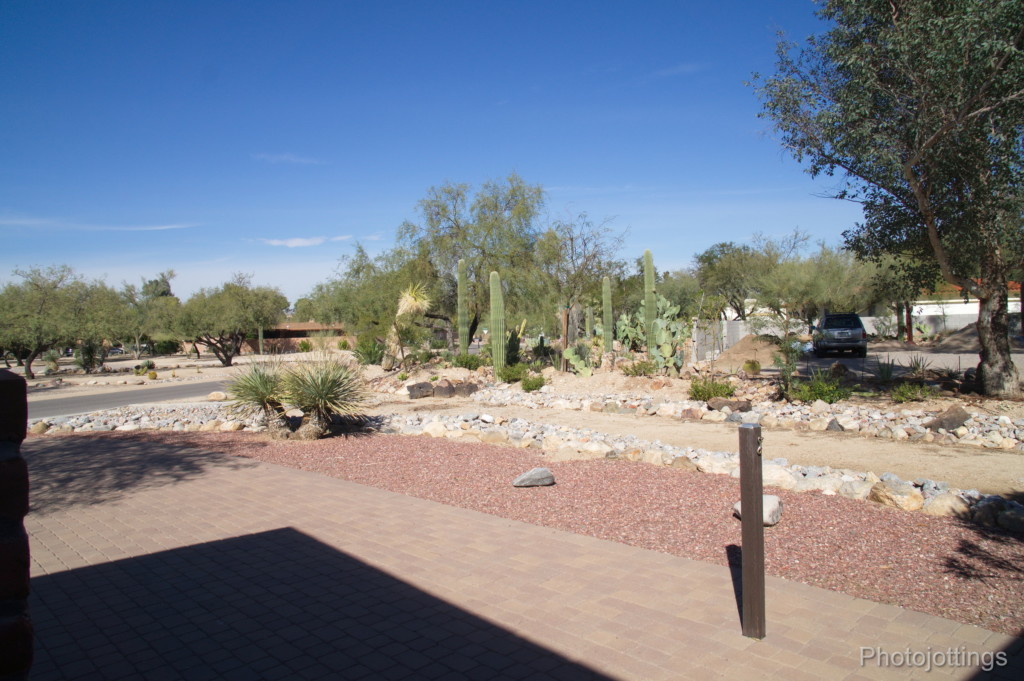 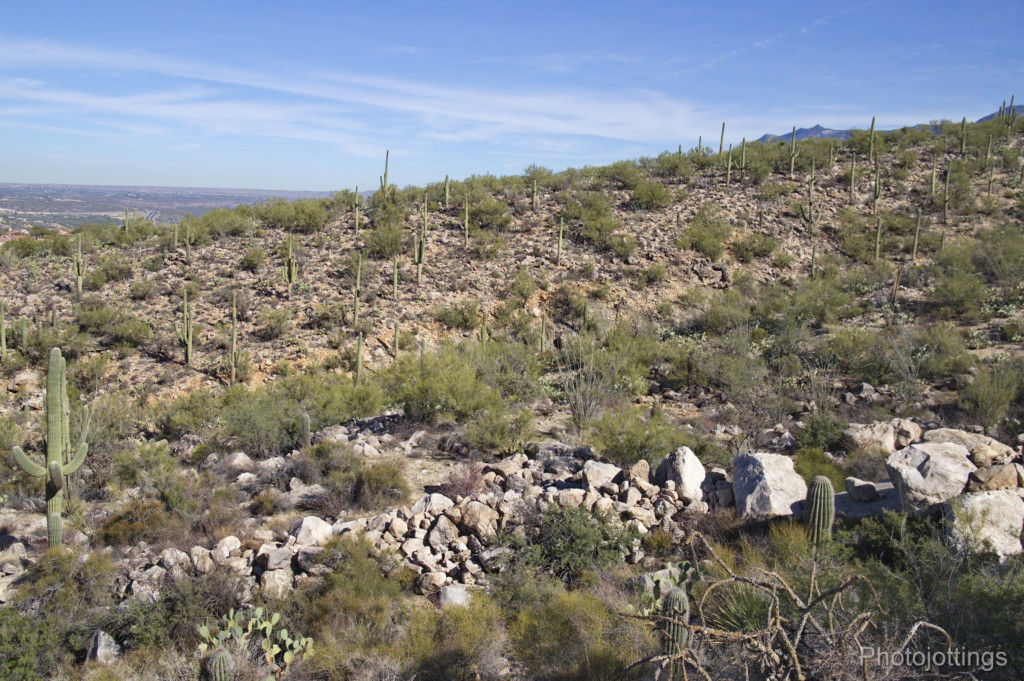  Click on yellow buttons for full size versions.
That’s it for the review, if you’d like to help out the site, please visit B&H Photo if you’re thinking of purchasing the Sony E mount 16-70mm F/4 OSS, thanks! |
